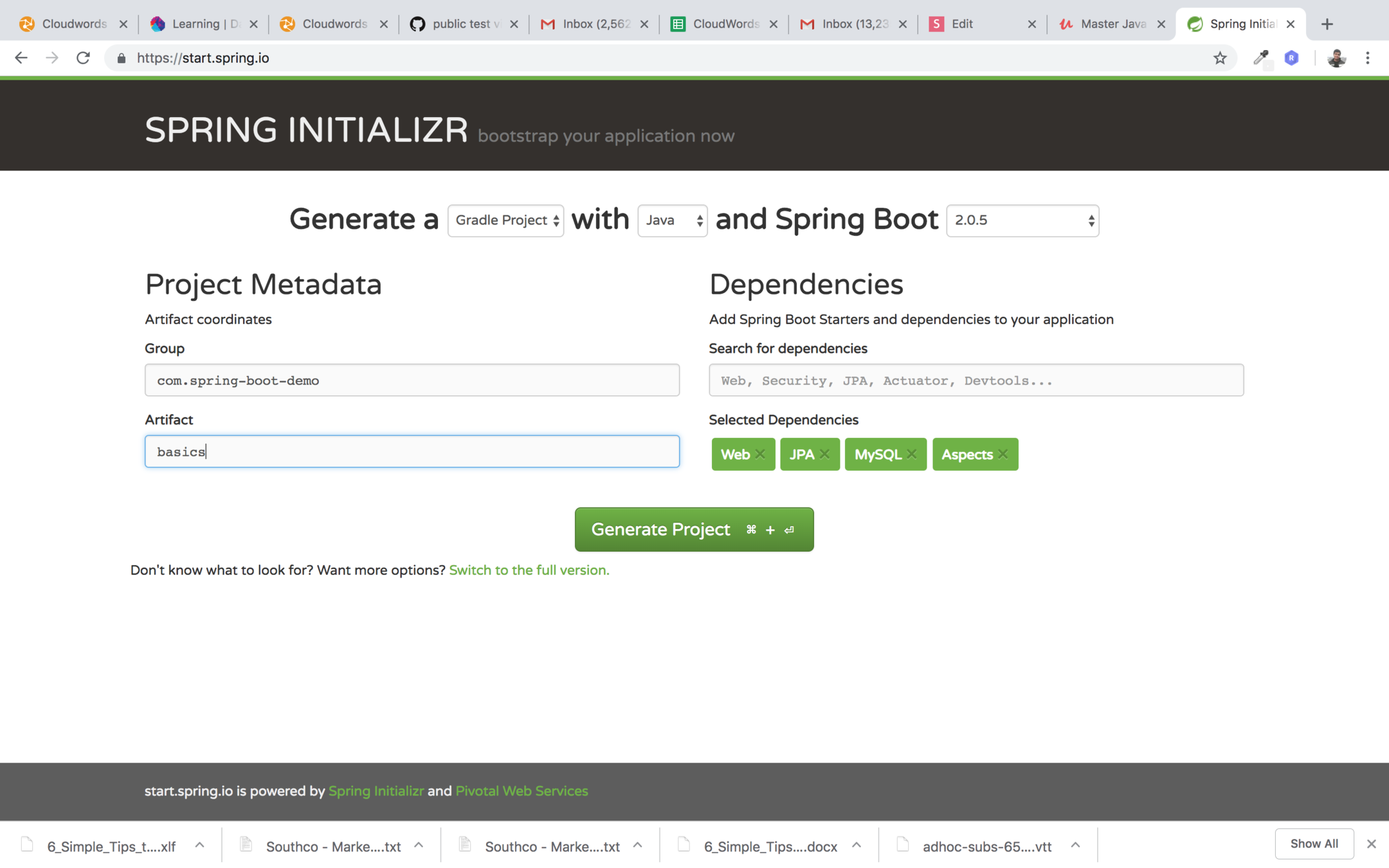Spring Boot
Spring Boot
Spring Boot makes it easy to create stand-alone, production-grade Spring based Applications that you can "just run".
Features of Spring boot
-
Create stand-alone Spring applications
-
Embed Tomcat, Jetty or Undertow directly (no need to deploy WAR files)
-
Provide opinionated 'starter' dependencies to simplify your build configuration
-
Automatically configure Spring and 3rd party libraries whenever possible
-
Provide production-ready features such as metrics, health checks and externalized configuration
-
Absolutely no code generation and no requirement for XML configuration
Developing Spring Application before Spring Boot
Using Spring Initializr to create Spring Boot Project
- Go to https://start.spring.io/
- With the help of option on the page create a gradle project with latest version of Spring Boot
- Download the project and import it in idea
- Once you import the project in Intellij Idea then try running the application by executing the Main Class
(Note : Please see the next slide to get know all the options you want to select)

Create a simple Rest Controller
package com.springbootdemo.basics.entity;
public class Book {
private Integer id;
private String name;
private String author;
public Book(Integer id, String name, String author) {
this.id = id;
this.name = name;
this.author = author;
}
public Integer getId() {
return id;
}
public void setId(Integer id) {
this.id = id;
}
public String getName() {
return name;
}
public void setName(String name) {
this.name = name;
}
public String getAuthor() {
return author;
}
public void setAuthor(String author) {
this.author = author;
}
}
package com.springbootdemo.basics.service;
import com.springbootdemo.basics.entity.Book;
import org.springframework.stereotype.Service;
import java.util.Arrays;
import java.util.List;
@Service
public class BookService {
public List<Book> getBooks(){
return Arrays.asList(new Book(1,"Book1","Author1"),
new Book(2,"Book2","Author2"));
}
}
package com.springbootdemo.basics.controller;
import com.springbootdemo.basics.entity.Book;
import com.springbootdemo.basics.service.BookService;
import org.springframework.beans.factory.annotation.Autowired;
import org.springframework.web.bind.annotation.GetMapping;
import org.springframework.web.bind.annotation.RestController;
import java.util.List;
@RestController
public class BookController {
@Autowired
BookService bookService;
@GetMapping("/books")
public List<Book> getBooks(){
return bookService.getBooks();
}
}
Difference between @RestController and @Controller
@SpringBootApplication
@SpringBootApplication indicates following things :
- Its a Spring Context File
- It performs component scan to register the spring bean
Configuring a Bean with Component Scan
package com.springbootdemo.basics.entity;
public interface HotDrink {
void prepareDrink();
}
package com.springbootdemo.basics.entity;
import org.springframework.beans.factory.annotation.Autowired;
import org.springframework.stereotype.Component;
@Component
public class Restaurant {
@Autowired
private HotDrink hotDrink;
public HotDrink getHotDrink() {
return hotDrink;
}
public void setHotDrink(HotDrink hotDrink) {
this.hotDrink = hotDrink;
}
}
package com.springbootdemo.basics.controller;
import com.springbootdemo.basics.entity.Restaurant;
import org.springframework.beans.factory.annotation.Autowired;
import org.springframework.stereotype.Controller;
import org.springframework.web.bind.annotation.GetMapping;
import org.springframework.web.bind.annotation.RestController;
@RestController
public class RestaurantController {
@Autowired
Restaurant restaurant;
@GetMapping("/prepareDrink")
public String prepareDrink(){
restaurant.getHotDrink().prepareDrink();
return "Drink is Ready";
}
}
Creating the bean in context file
package com.springbootdemo.basics.entity;
public class Restaurant {
private HotDrink hotDrink;
public HotDrink getHotDrink() {
return hotDrink;
}
public void setHotDrink(HotDrink hotDrink) {
this.hotDrink = hotDrink;
}
}
package com.springbootdemo.basics;
import com.springbootdemo.basics.entity.HotDrink;
import com.springbootdemo.basics.entity.Restaurant;
import com.springbootdemo.basics.entity.Tea;
import org.springframework.boot.SpringApplication;
import org.springframework.boot.autoconfigure.SpringBootApplication;
import org.springframework.context.annotation.Bean;
@SpringBootApplication
public class BasicsApplication {
@Bean
public Restaurant restaurant(HotDrink hotDrink){
Restaurant restaurant= new Restaurant();
restaurant.setHotDrink(hotDrink);
return restaurant;
}
@Bean
Tea tea(){
return new Tea();
}
public static void main(String[] args) {
SpringApplication.run(BasicsApplication.class, args);
}
}
application.properties
- We can place certain common properties which will be used at many places in a common place known as application.properties
app.name=My basic app- Following is the way to retrieve the value from the properties file:
package com.springbootdemo.basics.controller;
import com.springbootdemo.basics.entity.Restaurant;
import org.springframework.beans.factory.annotation.Autowired;
import org.springframework.beans.factory.annotation.Value;
import org.springframework.stereotype.Controller;
import org.springframework.web.bind.annotation.GetMapping;
import org.springframework.web.bind.annotation.RestController;
@RestController
public class RestaurantController {
@Autowired
Restaurant restaurant;
@Value("${app.name}")
String appName;
@GetMapping("/prepareDrink")
public String prepareDrink(){
System.out.println("App Name is : "+appName);
restaurant.getHotDrink().prepareDrink();
return "Drink is Ready";
}
}
- profile-specific properties can also be defined by using the following naming convention: application-{profile}.properties
- We can also specify some app specific configurations which will be automatically picked by spring boot e.g
server.port=8081After setting the value above if you try to run application then it will run on port 8081
Different ways of running a Spring Boot App
- Run the Main java class marked with @SpringBootApplication Annotation and contains main method as follows:
public static void main(String[] args) {
SpringApplication.run(BasicsApplication.class, args);
}- Execute the bootRun Gradle tasks
- Create an Executable jar with the help of bootJar Gradle task. This task will build an executable jar inside build/libs folder. Now execute the jar files using command below:
java -jar basics-0.0.1-SNAPSHOT.jar
java -jar basics-0.0.1-SNAPSHOT.jar --spring.profiles.active=prod
java -jar basics-0.0.1-SNAPSHOT.jar --server.port=8080Logging Levels
| Level | Description |
|---|---|
| TRACE | Designates finer-grained informational events than the DEBUG. |
| DEBUG | Designates fine-grained informational events that are most useful to debug an application. |
| INFO | Designates informational messages that highlight the progress of the application at coarse-grained level. |
| WARN | Designates potentially harmful situations. |
| ERROR | Designates error events that might still allow the application to continue running. |
Setting the log level in Spring Boot
We can set the log level in spring boot my mentioning the log level in application.properties as follows:
logging.level.root=TRACE
logging.level.com.springbootdemo.basics.controller=INFOpackage com.springbootdemo.basics.controller;
import org.slf4j.Logger;
import org.slf4j.LoggerFactory;
import org.springframework.web.bind.annotation.RequestMapping;
import org.springframework.web.bind.annotation.RestController;
@RestController
public class LoggingController {
Logger logger = LoggerFactory.getLogger(LoggingController.class);
@RequestMapping("/logging")
public String index() {
logger.trace("A TRACE Message");
logger.debug("A DEBUG Message");
logger.info("An INFO Message");
logger.warn("A WARN Message");
logger.error("An ERROR Message");
return "Logs Printed....";
}
}
Perform some operation when application starts
package com.springbootdemo.basics.event;
import org.springframework.boot.context.event.ApplicationStartedEvent;
import org.springframework.context.event.EventListener;
import org.springframework.stereotype.Component;
@Component
public class Bootstrap {
@EventListener(ApplicationStartedEvent.class)
public void init(){
System.out.println("Your Application is up and running");
}
}
Configure Spring Data JPA
application.properties
spring.datasource.url=jdbc:mysql://localhost/rest_with_spring
spring.datasource.username=root
spring.datasource.password=
spring.datasource.driver-class-name=com.mysql.jdbc.Driver
spring.jpa.hibernate.ddl-auto=createpackage com.springbootdemo.basics.entity;
import javax.persistence.Entity;
import javax.persistence.Id;
@Entity
public class Book {
@Id
private Integer id;
private String name;
private String author;
public Book(Integer id, String name, String author) {
this.id = id;
this.name = name;
this.author = author;
}
public Integer getId() {
return id;
}
public void setId(Integer id) {
this.id = id;
}
public String getName() {
return name;
}
public void setName(String name) {
this.name = name;
}
public String getAuthor() {
return author;
}
public void setAuthor(String author) {
this.author = author;
}
}
Convert Book Class in to hibernate entity
CrudRepository for Book
package com.springbootdemo.basics.repository;
import com.springbootdemo.basics.entity.Book;
import org.springframework.data.repository.CrudRepository;
public interface BookRepository extends CrudRepository<Book, Integer> {
}
package com.springbootdemo.basics;
import com.springbootdemo.basics.entity.HotDrink;
import com.springbootdemo.basics.entity.Restaurant;
import com.springbootdemo.basics.entity.Tea;
import org.springframework.boot.SpringApplication;
import org.springframework.boot.autoconfigure.SpringBootApplication;
import org.springframework.boot.autoconfigure.domain.EntityScan;
import org.springframework.context.annotation.Bean;
import org.springframework.data.jpa.repository.config.EnableJpaRepositories;
@SpringBootApplication
@EntityScan(basePackages = {"com.springbootdemo.basics.entity"})
@EnableJpaRepositories(basePackages = {"com.springbootdemo.basics.repository"})
public class BasicsApplication {
@Bean
public Restaurant restaurant(HotDrink hotDrink) {
Restaurant restaurant = new Restaurant();
restaurant.setHotDrink(hotDrink);
return restaurant;
}
@Bean
Tea tea() {
return new Tea();
}
public static void main(String[] args) {
SpringApplication.run(BasicsApplication.class, args);
}
}
Enabling JPA Repository
Bootstraping Initial data
package com.springbootdemo.basics.event;
import com.springbootdemo.basics.entity.Book;
import com.springbootdemo.basics.repository.BookRepository;
import org.springframework.beans.factory.annotation.Autowired;
import org.springframework.boot.context.event.ApplicationStartedEvent;
import org.springframework.context.event.EventListener;
import org.springframework.stereotype.Component;
import java.util.Iterator;
@Component
public class Bootstrap {
@Autowired
BookRepository bookRepository;
@EventListener(ApplicationStartedEvent.class)
public void init() {
Iterator<Book> bookIterable = bookRepository.findAll().iterator();
if (!bookIterable.hasNext()) {
for (int i = 1; i <= 10; i++) {
Book book = new Book(i, "Book " + i, "Author " + i);
bookRepository.save(book);
System.out.println("Book " + i + " created");
}
}
System.out.println("Your Application is up and running");
}
}
Getting the books from database
package com.springbootdemo.basics.service;
import com.springbootdemo.basics.entity.Book;
import com.springbootdemo.basics.repository.BookRepository;
import org.springframework.beans.factory.annotation.Autowired;
import org.springframework.stereotype.Service;
import java.util.ArrayList;
import java.util.Iterator;
import java.util.List;
@Service
public class BookService {
@Autowired
BookRepository bookRepository;
public List<Book> getBooks(){
List<Book> bookList = new ArrayList<>();
Iterator<Book> bookIterator = bookRepository.findAll().iterator();
bookIterator.forEachRemaining(bookList::add);
return bookList;
}
}

Spring Boot
By Pulkit Pushkarna
Spring Boot
- 1,963



